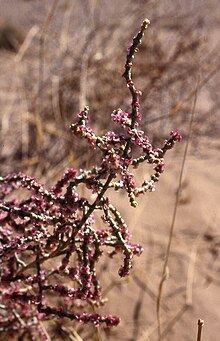Hammada is a genus of flowering plants belonging to the family Amaranthaceae.[1] It is also in the Salsoloideae subfamily.[2] Although it is a very unclear and unsorted genus with many species that have later been classed as synonyms.
| Hammada | |
|---|---|

| |
| Haloxylon griffithii | |
| Scientific classification | |
| Kingdom: | Plantae |
| Clade: | Tracheophytes |
| Clade: | Angiosperms |
| Clade: | Eudicots |
| Order: | Caryophyllales |
| Family: | Amaranthaceae |
| Subfamily: | Salsoloideae |
| Genus: | Hammada Iljin |
Its native range is Central Asia and is found in Iraq, Lebanon, Palestine, Syria, Turkey and Uzbekistan.[1] They are often found growing in alkaline or saline habitats.[3]
Description
editThey are perennial plants, with a glabrous (smooth) wood (only at the base). They can grow up to 40–60 cm (16–24 in) tall.[4] The weed-like plants have regular, minute, or small, cyclic flowers. The flowers have no petals, but 5 sepals which are united at the base. It has 5 stamens and the ovary is positioned superior and consists of 2 united carpels. Which late matures into a fruit (or seed capsule).[3]
Known species
editAccording to Plants of the World Online;[1]
- Hammada eriantha Botsch.[5] (from Uzbekistan)
- Hammada ramosissima (Boiss. ex Eig) Iljin (from Iraq, Lebanon, Palestine, Syria and Turkey)
Although, Schüssler in 2017, listed the following species; Hammada eriantha Botsch., Hammada griffithii (Moq.) Iljin, Hammada negevensis Iljin & Zoh., Hammada salicornica (Moq.) Iljin, Hammada schmittiana (Pomel) Botsch. and Hammada thomsonii (Bunge) Iljin.[2]
It is not known what the genus name of Hammada is in reference to, but Hamada in Arabic is a desert landscape.
It was first described and published in Bot. Zhurn. (Moscow & Leningrad) Vol.33 on page 582 in 1948.[1]
The genus is not recognized by the United States Department of Agriculture and the Agricultural Research Service, as they list it as a synonym of Haloxylon Bunge.[6]
Note; Hammada scoparia (Pomel) Iljin a former species in the genus, is classed as an accepted synonym of Haloxylon scoparium Pomel.[7]
References
edit- ^ a b c d "Hammada Iljin | Plants of the World Online | Kew Science". Plants of the World Online. Retrieved 13 January 2022.
- ^ a b Schüssler, Christina; Freitag, Helmut; Koteyeva, Nuria; Schmidt, Denise; Edwards, Gerald; Voznesenskaya, Elena; Kadereit, Gudrun (1 January 2017). "Molecular phylogeny and forms of photosynthesis in tribe Salsoleae (Chenopodiaceae)". Journal of Experimental Botany. 68 (2): 207–223. doi:10.1093/jxb/erw432. PMC 5853613. PMID 28003310.
- ^ a b "Flora of Israel | Chenopodiaceae | plant family". www-flowersinisrael-com.translate.goog. Retrieved 13 January 2022.
- ^ Michael Zohary Flora Palaestina, Volume 1 (1966), p. 166, at Google Books
- ^ S. K. Czerepanov, Sergeĭ Kirillovich Cherepanov Vascular Plants of Russia and Adjacent States (the Former USSR) (1995), p. 185, at Google Books
- ^ "Genus Hammada Iljin". npgsweb.ars-grin.gov. Retrieved 13 January 2022.
- ^ "Hammada scoparia (Pomel) Iljin | Plants of the World Online | Kew Science". Plants of the World Online. Retrieved 13 January 2022.